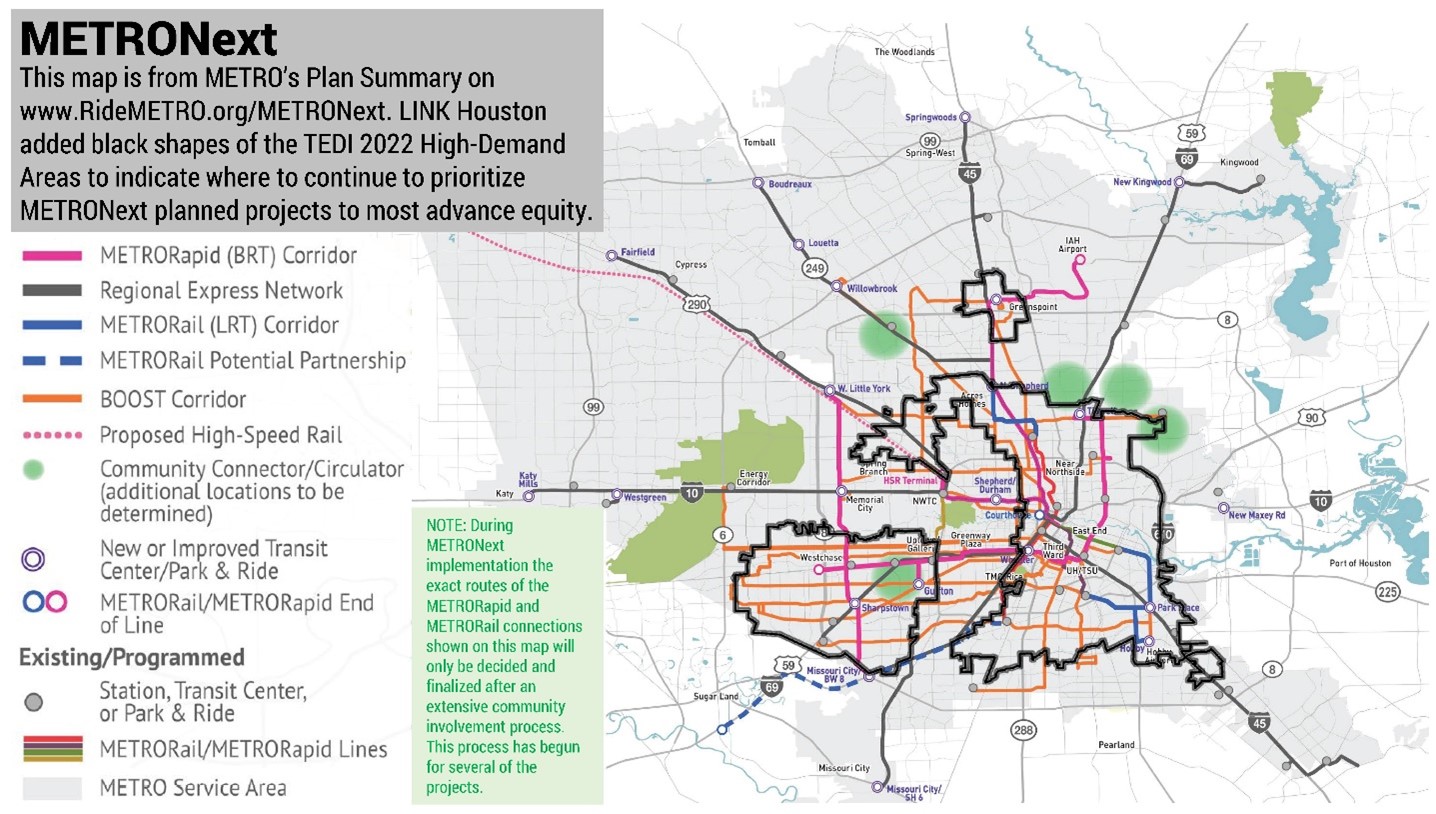
Executive Summary
Public transit plays a central role in connecting people to jobs, education, health care, and many other opportunities. Equity in Transit: 2022 combines data analysis and riders’ experiences collected through the 2022 Houston Bus Rider Survey. The report explores how transit has, and should, connect people to opportunity in Houston, with a particular focus on the Gulfton community in southwest Houston. A community research team of residents, bus riders, and civic leaders in the Gulfton area guided LINK Houston’s work to understand how transit can be better and support Houston’s, especially Gulfton’s, growth.
The report seeks to influence infrastructure improvements and bus service quality improvements by the Metropolitan Transit Authority of Harris County, TX (METRO), the City of Houston, and other local stakeholders (i.e., the new Gulfton Management District). METRO’s service area contains nearly 4.4 million people live, of which 3.1 million are people of color. The 2022 Transportation Equity Demand Index (TEDI) found 1.3 million people live in three high-demand areas where demand for better transit is especially high based on the 15 factors studied (e.g., lower incomes, more households with no vehicle, and more people using transit). Many Houstonians need affordable transportation to reach opportunity safely and reliably with dignity. Equity in Transit: 2022 calls on METRO to act and enables transit riders and advocates to hold decision-makers accountable to prioritize improvements desired by people already riding METRO’s services.
Surveyors asked riders and residents in Gulfton what was working well now and what should be better about riding METRO. People want service reliability and frequency to return, and then exceed, pre-pandemic levels.
#1 Top Priority: Reliable Information and Services
#2 Priority: 15-minute Frequency
#3 Priority: Create Shaded, Safe, Clean, and Comfortable Transit Stops
LINK Houston and the Gulfton community research team recommend several infrastructure and physical improvements (improving people’s opportunity to reach stops as well as service quality improvements (improving people’s opportunity to reach destinations) to METRO, City of Houston, the Gulfton Management District, and other partners, see Table ES-1. The process to implement recommendations is as important as the outcome. Full and consistent inclusion of active riders and residents in decision-making is imperative for specific equitable improvements to occur and systemic change to result. METRO and stakeholders must prioritize investments in TEDI high-demand areas (see Figure ES-1). LINK Houston will continue to seek opportunities to support communities through education and collaborative action.
Table ES-1. Summary of Recommendations.
| #1 Top Priority: Reliable Information and Services
METRO must prioritize the BOOST (Bus Operations Optimized System Treatments) network to improve reliability through optimized stop locations and traffic signal priority. METRO should re-double any existing efforts to align printed, online, and day-of schedule so riders can reliably plan and execute trips. When changing or adding stops, METRO must ensure all new transit stops, such as those along the 309/310 Gulfton Circulator, exist in online trip planners and real-time information. |
| #2 Priority: 15-minute Frequency
METRO must fully restore the frequency of transit and prioritize METRONext implementation of projects involving the local bus network (including BOOST improvements on local bus corridors). METRO and local government partners should coordinate with schools to ensure that sufficient transit capacity and safe, practical paths for walking and biking exist for students (i.e., around high schools like Wisdom High School). |
| #3 Priority: Create Shaded, Safe, Clean, and Comfortable Transit Stops
METRO must make more stops comfortable, functional, green, and safe to improve bus riders’ experience. METRO and local governments should partner with community organizations and nonprofits to create more shade or shelter. Local governments must maintain stormwater drainage to prevent standing water next to bus stops and install sufficient street lighting to promote safe use of transit services. Standing water near stop means passing vehicles splash water onto waiting passengers. It is not safe to wait for a bus with no light and drivers cannot see when to stop to pick up people waiting. METRO must maintain and clean stops more consistently. |
| Enhance Customer Service
METRO must improve customer service and the onboard experience, such as by improving customer-operator interactions, ensuring onboard amenities for charging and Wi-Fi function reliably, etc. |
| Further Universally Accessible and Practical Access to Transit
METRO must continue improving every transit stop and station to ensure universal accessibility and reevaluate the process and metrics governing how bus stops qualify for necessities (e.g., shelter, seating, lighting, trash bins) with special consideration of transfer points (especially where off-peak service frequency is 30 minutes or longer). Local governments, and METRO, must take the lead to create more and better sidewalks and bikeways. |
| Extend Hours and Network Coverage
METRO should study and plan to strategically extend service hours on routes connecting riders to and from TEDI high-demand areas and extended-hour activity centers. METRO should strategically add additional bus trips earlier and/or later as part of a longer-term plan to create some level of 24-hour service—and then market the new services and schedule to riders. METRO should study potential service gaps left after implementing the METRORapid Silver Line. |

Figure ES-1. METRONext and 2022 TEDI High-Demand Areas.
Note: www.RideMETRO.org/METRONextcontains a complete summary of each METRONext plan element listed in the legend in Figure ES-1.